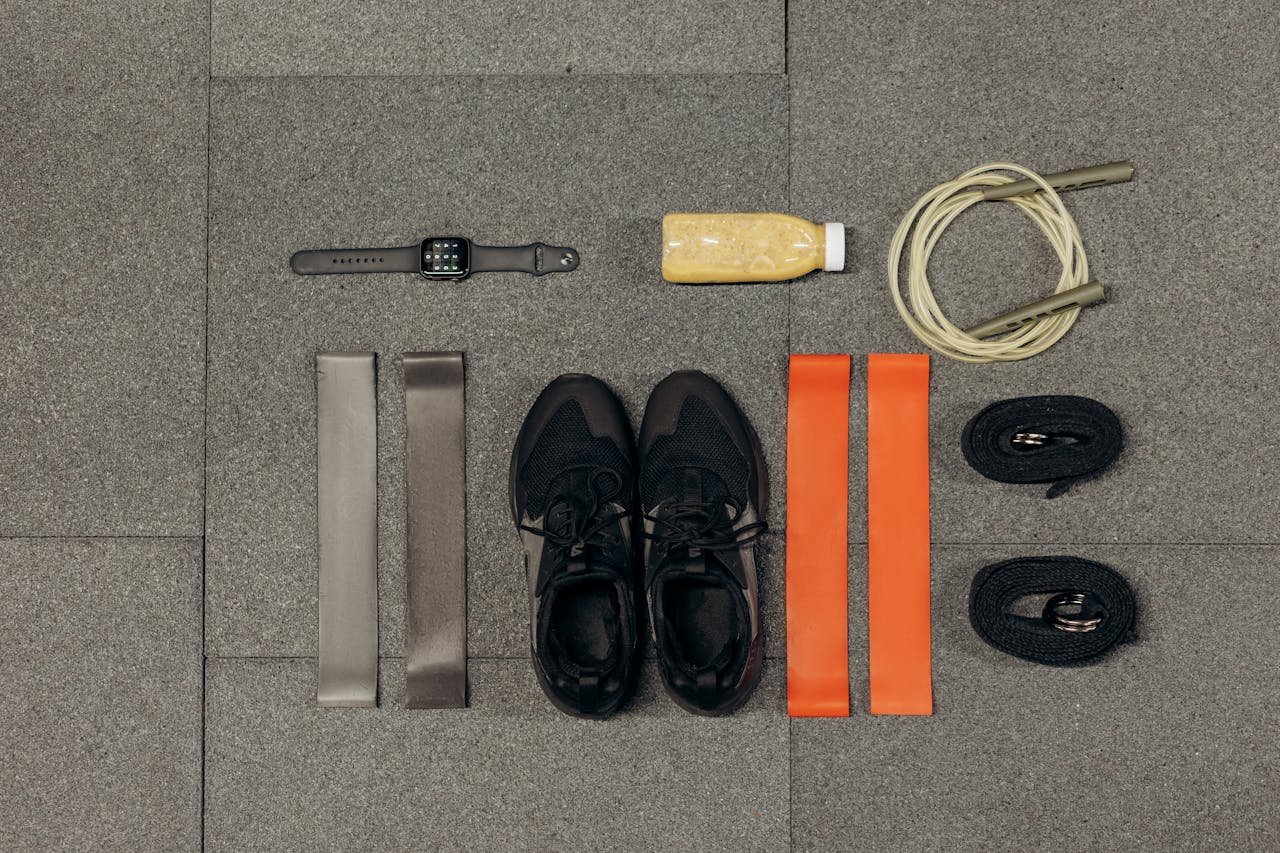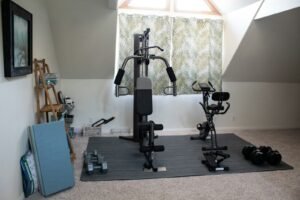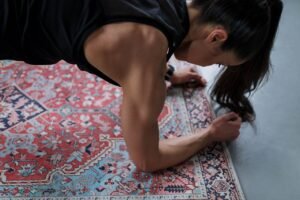(Or: How to Turn a Spare Corner into Your New Favorite Place to Sweat)
Assessing Your Space: AKA Don’t Put a Treadmill in Your Closet
Let’s discuss your possible home gym space before ordering kettlebells like they’re going out of style. Evaluating your workout zone is step one in designing a smart home gym that doesn’t feel like a game of fitness-themed Tetris.
Start by measuring your home gym space—yes, with actual numbers. Grab a tape measure and jot down the length, width, and ceiling height. While you’re at it, check for things like doors that swing in unexpectedly, low-hanging lights (ouch), or rogue furniture that might ambush your burpees.
Next, think about your workout style. Do you love resistance bands and bodyweight training? You probably don’t need a full rack of iron. But if you’re into rowing, lifting, or virtual boxing sessions, give yourself enough breathing room for those significant, sweeping movements.
Look for versatile gear. Adjustable dumbbells? Yes, please. Resistance bands? Absolutely. A folding bench? Chef’s kiss. The goal is to maximize the equipment-to-footprint ratio, so your living room still feels like a living room when you’re not lunging across it.
Pro tip: don’t ignore airflow and lighting. Nobody wants to train in a musty cave. Natural light is great for motivation (and post-workout selfies), and good ventilation keeps things fresh. Bonus: mirrors can create the illusion of more space and help you check your form—double win.
And don’t forget about safety. Consider rubber mats or foam tiles if your floor is slicker than a Zumba class in socks. Cushioning saves joints, prevents injuries, and makes your space feel more intentional.
Lastly, think long-term. Your workouts—and your gear—may evolve. Choose a spot with room to grow and storage options that don’t involve turning your yoga mat into a tripping hazard.
Creating a Functional Home Gym Layout: Because Your Dumbbells Deserve a Home Too
Designing your home gym layout is like setting up a kitchen: You want the tools you use most within reach, and ideally, you don’t want to trip over a rogue kettlebell mid-lunge. Whether your gym is in a spare bedroom, a basement nook, or squeezed between your couch and TV, a clever layout can distinguish between a space that inspires sweat… and one that collects laundry.
Step One: Divide and Conquer (Your Space, That Is)
Think in zones before you start tossing yoga mats and resistance bands around like confetti. Giving each “type” of workout its little footprint makes your gym feel organized, even if it’s only 6×6 feet, and also your guest room.
Strength Zone
This is where the heavy stuff lives. Think dumbbells, resistance bands, a compact bench, kettlebells, or a squat stand if space allows. Ideally, this area has some floor space for movement and good lighting to check your form (or flex).
Cardio Corner
Whether it’s a foldable treadmill, a stationary bike, or just your favorite jump rope and HIIT timer, this space should be ready for action—and sweat. If machines aren’t within budget or footprint, opt for agility ladders, a mini trampoline, or simply your body moving with wild enthusiasm.
Flexibility & Recovery Area
Every gym needs a calm corner. Lay down your mat for yoga, foam rolling, breathwork, or pretending to stretch while you lie there for five minutes. Add a bolster and some mobility tools, and you’ve got a recovery oasis.
Step Two: Maximize the Gear You’ve Got for Your Home Gym
Compact equipment is your best friend—especially when space is tighter than your hamstrings after leg day.
Adjustable dumbbells: One sleek set replaces an entire rack. It’s like a transformer for your biceps.
Resistance bands are light, versatile, and easy to hang, roll, or cram into a drawer without guilt.
Foldable benches disappear faster than your motivation at 5 a.m. and work just as hard.
Multipurpose equipment is also a win. A sturdy bench can double as a box for step-ups. A yoga mat can become your foundation for strength, stretching, and core work. And a Swiss ball? Great for stability—and for rolling across the room like a large, judgmental cat toy.
Step Three: Go Vertical (Yes, Even in a Basement)
Let’s talk wall power. You’ve got precious real estate up there—use it!
Wall-mounted racks or pegboards can hold bands, jump ropes, and mats.
Hooks work beautifully for storing kettlebells, stability balls, and even your headphones.
Floating shelves can stash towels, chalk, or your collection of protein bars you keep forgetting to eat.
If it can be lifted off the floor, do it. Your feet—and your feng shui—will thank you.
Step Four: Design for Accessibility (Not Just Aesthetics)
If you or someone in your household is older, has mobility concerns, or prefers not to trip on a yoga block at 6 a.m., layout becomes even more critical.
Keep walkways wide enough for easy movement.
Tuck away cords, store equipment when not in use, and avoid piles of “I’ll get to that later” to eliminate trip hazards.
Choose lightweight, easy-to-move equipment, especially if you set up and break down your gym regularly.
Add supportive tools like a stability chair, balance pads, or grip-friendly bands for safe functional movement work.
Creating an accessible gym doesn’t mean compromising function—it means leveling up one’s ability to train consistently, safely, and confidently.
Step Five: Organize Like You Mean It
A tidy gym isn’t just visually satisfying—it’s functional. If you have to move seven things to get to your dumbbells, you’re not going to lift them (or you’ll do so angrily). Keep things where they belong with:
Storage bins or baskets for loose accessories like sliders, bands, or gloves.
Drawer organizers or old-school toolboxes for smaller items.
A laundry basket or towel hook keeps things fresh, not funky.
Not only does this reduce distractions during workouts (where did that foam roller go?), but it also saves you time and makes your space feel more professional, even if you’re working out in socks and yesterday’s sweatpants.
Design With Flow (and Flexibility) in Mind for Your Home Gym
The best layout is the one that flows with you. It should support your routine, match your vibe, and evolve as your goals shift. Maybe you start with yoga and a resistance band and then grow into strength training. Maybe it’s all about dance this month and mobility next. That’s the beauty of a home gym—it moves with your life.
So yes, your dumbbells deserve a home. But so do you. Make it a space you want to be in—because consistency loves convenience, and your goals deserve a place that feels like a little celebration zone.
Would you like a checklist or a sample gym layout plan next?
Personalizing Your Home Gym: Your Space, Your Vibe
Once the bones are in place—your layout, gear, safe-to-squat floor—it’s time for the fun part: giving your gym some personality. Because let’s be honest, if it doesn’t feel like your space, you’re less likely to use it. This isn’t just where you sweat. This is where you focus, push yourself, yell into a towel, and occasionally lie on the mat wondering what happened. Make it count.
Step One: Know Thyself (and Thy Fitness Goals)
Before you start decorating like it’s HGTV: Home Gym Edition, ask yourself the big question: What’s your fitness goal?
Building muscle? You’ll want space for strength gear: adjustable dumbbells, a sturdy bench, resistance bands, and a squat rack or power cage if you’ve got the square footage. Add a pull-up bar for bonus strength moves without hogging floor space.
Chasing cardio and weight loss? Think in terms of movement and sweat. A foldable treadmill or compact rowing machine can give you solid cardio without eating up the whole room. No space? A jump rope, agility ladder, or HIIT timer app might be all you need.
Focusing on flexibility and recovery? Your toolkit should include yoga mats, blocks, bolsters, foam rollers, and maybe even a massage gun (yes, you’re fancy now). Throw in some lavender essential oil or calming music; suddenly it’s a spa with squats.
Training for balance and mobility? Resistance bands with handles, Bosu balls, and balance boards are underrated MVPs. They are great for older adults, beginners, or anyone who wants to stop rolling their ankles during hikes.
Want to mix it up? Suspension trainers (like TRX), kettlebells, or a battle rope can add intensity and fun without occupying permanent space. A mini trampoline (a.k.a. rebounder) is weirdly joyful and surprisingly sweaty.
Step Two: Make It a Place You Want to Be
Now let’s talk atmosphere. You don’t have to hang disco balls (unless… you want to), but your gym should feel welcoming, motivating, and yours.
Set the vibe. Hang motivational quotes that fire you up—or make you laugh. (“Sweat now, pizza later” is a classic.) Display your goals. Post your favorite mantra. The visual reminders can make a big difference on days when the couch is calling.
Crank the tunes. A good Bluetooth speaker is practically gym equipment. Create playlists for different moods—beast mode, yoga calm, dance break. If music isn’t your thing, try guided workouts or motivational podcasts.
Add texture and color. A vibrant mat, an inspiring wall color, even a cozy rug in your stretching zone—these small touches can change how the space feels. Don’t underestimate the power of “not drab” when trying to hype yourself up for burpees.
Let it breathe. Air circulation matters if your home gym’s in a basement or garage. A small fan can keep things cool, and a window (if you’ve got one) is your best friend. Stale air = stale motivation.
Bring life into it—literally. Plants are a great addition to any gym space. They purify the air, lift your mood, and quietly judge when you skip leg day. Just keep them out of swinging range.
Step Three: Track Your Journey, Not Just Your Sets
A tracking system is a game-changer if you’re goal-driven (or forgetful).
A whiteboard or chalkboard wall lets you log your workouts, plan your week, or write new PRs in big, proud letters.
A fitness journal is great for writing reflections, tracking sleep and hydration, or reminding yourself how far you’ve come on tough days.
Into tech? Use a fitness app or smartwatch that logs everything from reps to heart rate to post-leg-day soreness levels.
Progress isn’t just numbers on a scale. It’s showing up, lifting heavier, balancing better, and feeling more energized. Make space to celebrate that.
If It Feels Like You, You’ll Use It
The best home gym isn’t about how much equipment you have—it’s about creating a space that reflects your goals, meets your needs, and makes you want to move. Whether you’re training for a marathon, managing stress through movement, or just trying to touch your toes without groaning, your gym should support you in every way.
So make it personal, powerful, and maybe hang a disco ball just because.
Final Thoughts: Smart Space, Strong You
Designing your smart home gym isn’t about turning your house into a CrossFit box (unless you want to). It’s about creating a space that makes movement easy, accessible, and—dare we say—fun.
Whether carving out a corner of your living room or converting your garage into a fortress of gains, the magic lies in thoughtful planning, versatile tools, and a setup that makes you want to show up.
So take measurements, get creative, and build a space that fits your body and your life. When your gym fits you, your goals suddenly feel a whole lot more doable.
Now grab that measuring tape—and maybe a resistance band or two—and let’s make your home gym work smarter, not harder.




